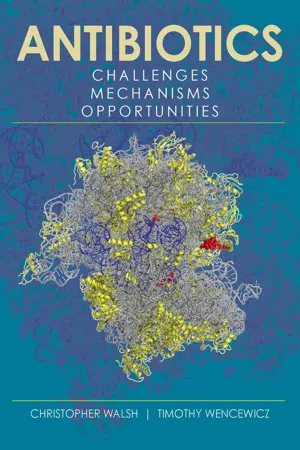
- English
- ePUB (mobile friendly)
- Available on iOS & Android
About this book
A chemocentric view of the molecular structures of antibiotics, their origins, actions, and major categories of resistance
Antibiotics: Challenges, Mechanisms, Opportunities focuses on antibiotics as small organic molecules, from both natural and synthetic sources. Understanding the chemical scaffold and functional group structures of the major classes of clinically useful antibiotics is critical to understanding how antibiotics interact selectively with bacterial targets.
This textbook details how classes of antibiotics interact with five known robust bacterial targets: cell wall assembly and maintenance, membrane integrity, protein synthesis, DNA and RNA information transfer, and the folate pathway to deoxythymidylate. It also addresses the universe of bacterial resistance, from the concept of the resistome to the three major mechanisms of resistance: antibiotic destruction, antibiotic active efflux, and alteration of antibiotic targets. Antibiotics also covers the biosynthetic machinery for the major classes of natural product antibiotics.
Authors Christopher Walsh and Timothy Wencewicz provide compelling answers to these questions:
- What are antibiotics?
- Where do antibiotics come from?
- How do antibiotics work?
- Why do antibiotics stop working?
- How should our limited inventory of effective antibiotics be addressed?
Antibiotics is a textbook for graduate courses in chemical biology, pharmacology, medicinal chemistry, and microbiology and biochemistry courses. It is also a valuable reference for microbiologists, biological and natural product chemists, pharmacologists, and research and development scientists.
Frequently asked questions
- Essential is ideal for learners and professionals who enjoy exploring a wide range of subjects. Access the Essential Library with 800,000+ trusted titles and best-sellers across business, personal growth, and the humanities. Includes unlimited reading time and Standard Read Aloud voice.
- Complete: Perfect for advanced learners and researchers needing full, unrestricted access. Unlock 1.4M+ books across hundreds of subjects, including academic and specialized titles. The Complete Plan also includes advanced features like Premium Read Aloud and Research Assistant.
Please note we cannot support devices running on iOS 13 and Android 7 or earlier. Learn more about using the app.
Information
Table of contents
- Cover Page
- Title Page
- Copyright Page
- Dedication
- Contents
- Preface
- Section I: Challenges for Antibiotics
- Section II: Mechanisms: Antibiotic Action by Bacterial Target Class
- Section III: Mechanisms: Bacterial Resistance to Antibiotics
- Section IV: Mechanisms: Antibiotic Biosynthesis
- Section V: Opportunities
- References
- Index